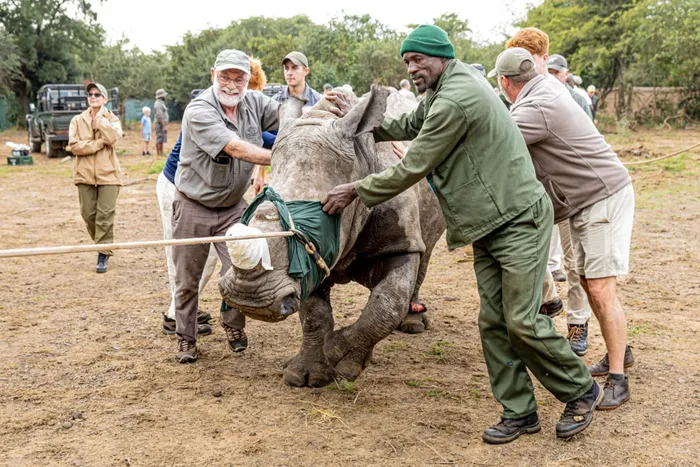KZN White Rhinos boost numbers in Congo’s Garamba National Park

White rhinos being directed into a national park in the DRC. Photo: African Parks.
Sixteen southern white rhinos have been safely transported to Garamba National Park in the Democratic Republic of the Congo.
This subspecies' introduction to the Garamba Complex (GC) gives hope that it will adapt and fulfil the same role as the now extinct northern white rhino.
In an innovative endeavour to restore the ecological balance of one of Africa's oldest national parks, 16 southern white rhinos from andBeyond Phinda Private Game Reserve in KwaZulu-Natal have been introduced to Garamba National Park in the Democratic Republic of the Congo (DRC).
According to a press release, the translocation was accomplished through a partnership between the Institut Congolais pour la Conservation de la Nature (ICCN), African Parks, andBeyond.
It was also sponsored by the Barrick Gold Corporation, which has pledged to support the initiative over the coming years.
This translocation is part of a larger conservation effort within the Garamba Complex (GC) to restore the park's complete complement of megaherbivores after the last northern white rhino was poached in 2006 and subsequently became functionally extinct.
Introducing southern white rhino to this region will increase Garamba National Park's contribution to the wildlife economy of the Democratic Republic of the Congo, ensuring that the conservation of the country's outstanding natural landscapes generates long-term advantages for local communities and all Congolese.
Director-general of the Institut Congolais pour la Conservation de la Nature Milan Ngangay Yves stated, "The return of white rhinos to the Democratic Republic of the Congo demonstrates our nation's commitment to biodiversity conservation."
"As Garamba is poised to become a globally significant sanctuary for megaherbivores, introducing southern white rhino to the country is an important step in advancing our contribution to rhino conservation in Africa," said Ngangay.
The sixteen rhinos came from the andBeyond Phinda Private Game Reserve in KZN.
The rhinos were transported from South Africa to Barrick's Kibali Mine airstrip in north-eastern DRC and then trucked to Garamba National Park in two separate operations.
This reintroduction is part of a larger strategy to promote the long-term conservation of white rhinos in Africa by expanding their range and establishing new reproductive nodes in secure areas.
CEO of African Parks, Peter Fearnhead, stated that efforts to save the northern white rhino were "too little, too late" and should never occur again.
This reintroduction marks the beginning of a process in which the southern white rhino, the closest genetic alternative to the northern white rhino, will assume the function of the northern white rhino in the landscape.
In KwaZulu Natal, a population of fewer than a hundred southern white rhinos was discovered in 1895, despite the fact that the species had been thought to be extinct since the late 19th century.
Today, they are classified as Near Threatened on the IUCN Red List. However, poaching has caused the white rhino population to decline again in recent years, with the current population estimated at over 15 000 animals.
The proactive relocation to Garamba seeks to repopulate areas where rhinos have become locally extinct and to establish healthy populations in secure areas. This strategic effort bears promise for the long-term viability of the species in the DRC.
andBeyond South Africa's conservation manager, Dale Wepener, explained, "It has been demonstrated that conservation translocations are a crucial tool for ensuring the survival of endangered species, such as the rhino."
"Our long-term goal as andBeyond is to conserve black and white rhinos. Creating new habitats and ranges is something that andBeyond has been doing for some time, as evidenced by our history of relocating rhinos from Phinda to other regions of Southern Africa," concluded Wepener.
In the coming years, additional rhinos will be relocated to Garamba National Park in order to establish a viable reproductive population.
Environment